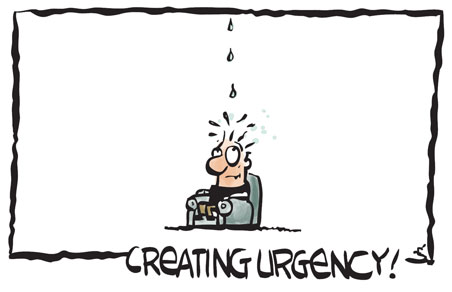(Also listen to the audio at the end of this article)

Let's say you have to pee.
So this is a normal bodily function, eh?
It means that if you feel that sensation, and you don't go soon enough, you'll be in trouble.
But how many of us go to the loo when we first feel the sensation?
And how many of your customers are buying your products or services in a bad economy?
Should you discount?
Should you put in bigger signs?
Should you send out a zillion emails?
Or would it be more prudent (yup, prudent), to understand the factor of urgency?
So what's this factor of urgency?
Let's analyse the situation:
1) The client has the need for your product/service.
2) They know you're the right person.
3) They even know where to go, and what to do.
They should be rushing to buy your product or service. But good grief, they're holding out.
Holding out?
What are they holding out for?
If a person has a backache, shouldn't they fix the backache right away?
If they have a backache that drives them insane shouldn't they be rushing to fix it? Yes, they should, and no they don't rush.
In fact, they're doing something quite the opposite
They're putting up with the pain.
They're putting up with the frustration.
They complain about it often enough, but won't get it fixed.
Surely that's madness.
Yes, but not on their part.
It's madness on your part!
You are the person to blame.
You haven't provided them an incentive.
Or haven't given clear instructions.
Or haven't created enough risk reversal.
Or haven't created urgency of any kind.
Which takes us back to someone in a dire need to pee
They're going to be uncomfortable soon enough.
So why won't they go?
There's no incentive: Is the toilet you're providing right next to where they are? There are no clear instructions: Do they know where to find the toilet? Can they see the signage?
Have you created a well-lit toilet area? Or is it dingy and kinda scary? And is there an urgency? Is this the last toilet for the next 50 miles?
Urgency isn't created with one angle.
There are half a dozen angles.
At the very least.
And each angle has its own job to do
Each angle removes one more objection.
Creates one more reason to act right away.
You see humans don't behave the way you think they behave.
They don't fall madly in love at first sight.
They don't buy stuff the moment they see it.
They don't even pee when they first need to.
They wait.
They wait.
They wait.
And it's your job to minimise that waiting time
By repeatedly educating your customers using different angles. But education isn't enough.
You have to give them a reason to buy.
You can't be shy about selling. And it's the education combined with the sales that creates the factor of urgency.
This understanding of urgency is critical in any economy.
But here's what happens in a good economy
People buy easily, because hey it's herd-mentality: You're buying, I'm buying, and so it's okay to buy.
But then the economy closes in.
The clouds graduate to that menacing shade of inky-blue.
And all this time, the herd-mentality hasn't gone away. Everyone is still following the herd.
Except now, no one is buying
You're not. And yup, I'm not.
So in that worsening economy, urgency becomes ever-so critical.
Even when people are quite clearly in trouble. Even whey know they have a need for a product or a service, they'll wait.
And the only thing that will get them to act, is an even bigger problem.
So let's take an example:
Let's say your customer needs to fix his roof.
It's raining. There are a dozen leaky spots in the house, and two dozen buckets.
But this customer is still waiting.
Unless someone educates him that if he does fix the roof, he'll pay a lot of bucks. But if he doesn't, then he'll end up paying twice as much, as the damage worsens.
And then, that ‘educator' must provide the incentives, instructions, risk-reversal and yes, urgency.
Over and over again.
From multiple angles.
You see, creating urgency isn't a one step
It's a series of steps.
We have to go, when we have to go, only because we feel safe to go. It's your job to create that safety net, with repeated education and sales.
And that's when the customer really goes.
Aaaaaaaaaaaaah.
What a relief, huh?
For both parties too. 🙂
Next Step: Want to get more Marketing Strategies? Find the entire marketing strategies series in text, audio with cartoons!

This reminds me of my doughter not going to toilet at school- and in the new school one of the girls’s expectation of the new school where clean toilets….
Thanks for sharing this.
Here is one reason one might not want to go….
http://news.bbc.co.uk/cbbcnews/hi/newsid_4350000/newsid_4353500/4353570.stm
Sean,
Another great post. I love how you came at your point from as many angles as we should come at creating urgency from.
Well-written! I can hardly wait to share it.
Regards,
Kelly
Thanks Kelly 🙂